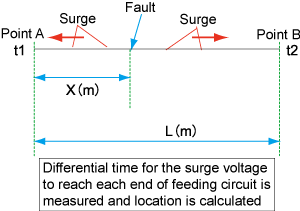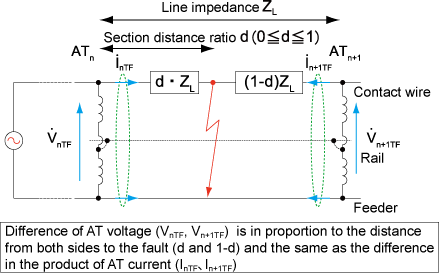9. Fault locator for an AC feeding system
- Fault locators for an AC feeding system stemming from two basic principles were developed.
- The surge-detection fault-locating system proved to offer an error margin 1/5 below the conventional method.
- The voltage drop fault locating system yielded a valid result with an error margin 1/3 beneath the conventional method.
High fidelity location of failures such as earth faults occurring in an AC feeder system must be fast to save downtime. However, the error margin in conventional systems is in the region of 1 km, driving the need for more accurate solutions.
The surge (transient voltage) is propagated at very high speed (approx. speed of light) from a fault location to the end of the feeding circuit. In the surge-detection fault-locating system, the time difference between arriving surges at each end of the circuit was detected and employed to calculate the location (Fig 1). This method demonstrated the results with an error margin 1/5 below the conventional method during field tests. This approach was therefore shown to be accurate, but when applied to high speed rail (Shinkansen), surges from changeover switches should be taken into consideration.
On the other hand, the potential difference in ATs (auto-transformers) on either side of the fault location is equal to the difference in the product of the distance of each AT to the fault location and fault current passing through each AT. The voltage drop fault-locating system uses this phenomenon and low voltage field tests showed that the error margin in this case could be reduced to 1/3 below that of the conventional method. This method utilizes more or less the same hardware as the conventional method.
Both fault-locating systems require synchronous measurement of the surge / fault current at each end of the circuit, and transmission towards the dispatcher, for calculation.
 Fig. 1 Surge detection based fault location
Fig. 1 Surge detection based fault location Fig. 2 Voltage drop based fault location
Fig. 2 Voltage drop based fault location Fig. 3 Composition of fault locating system
Fig. 3 Composition of fault locating system